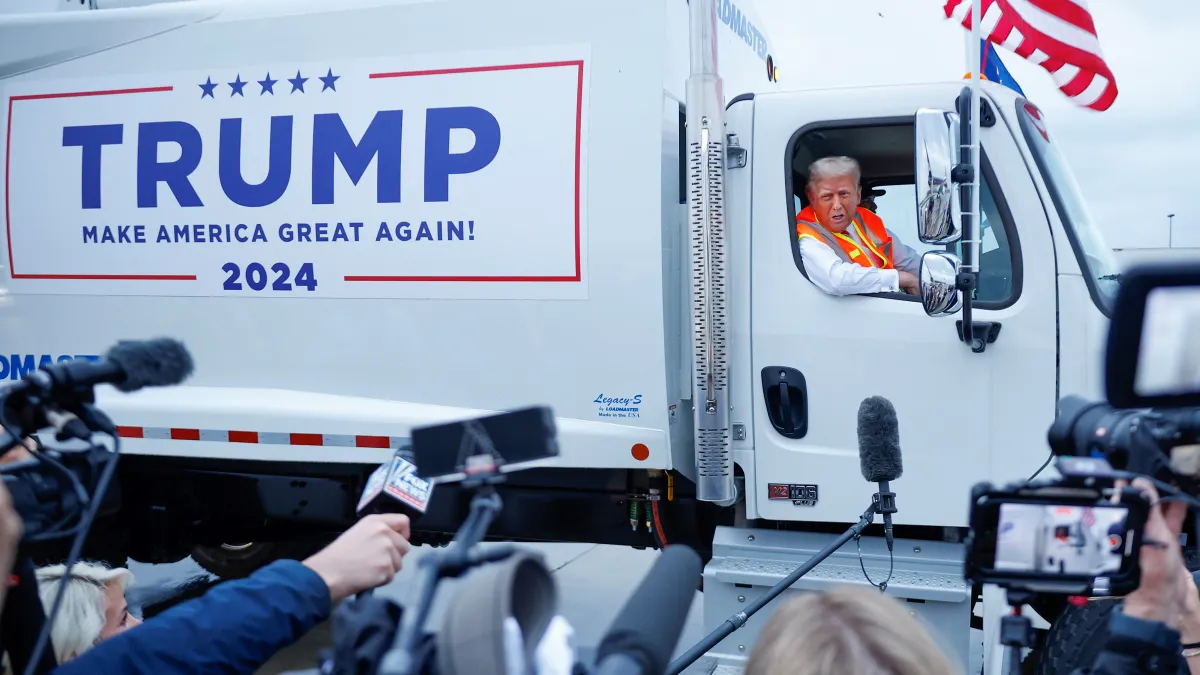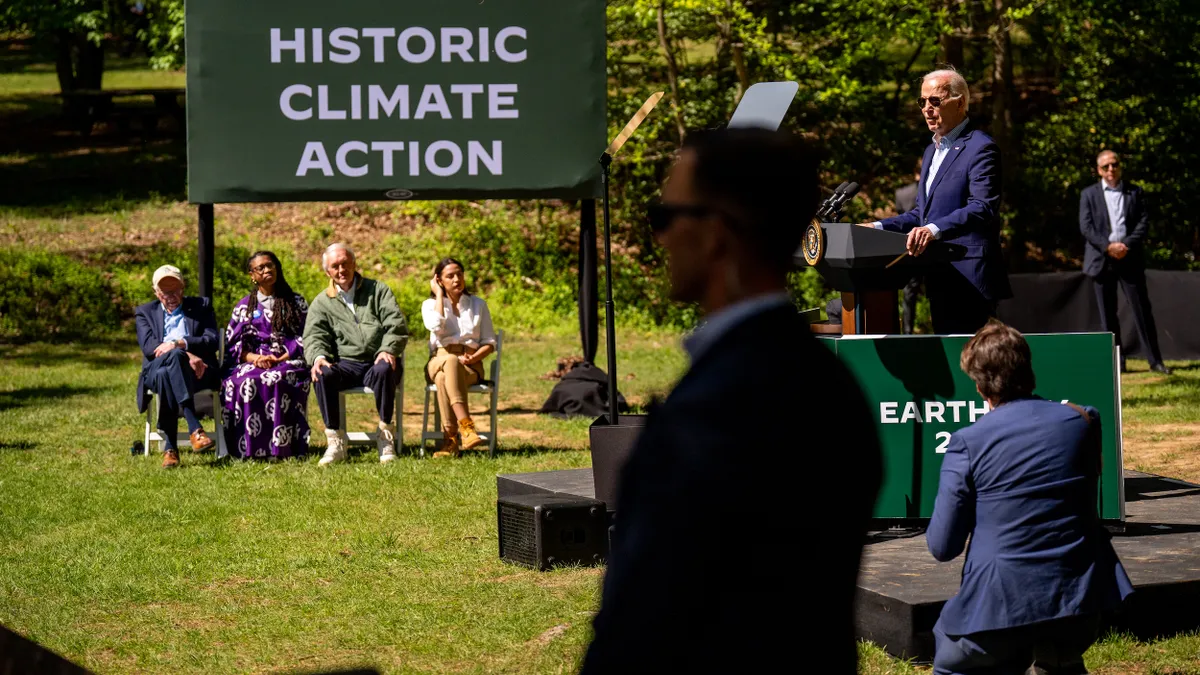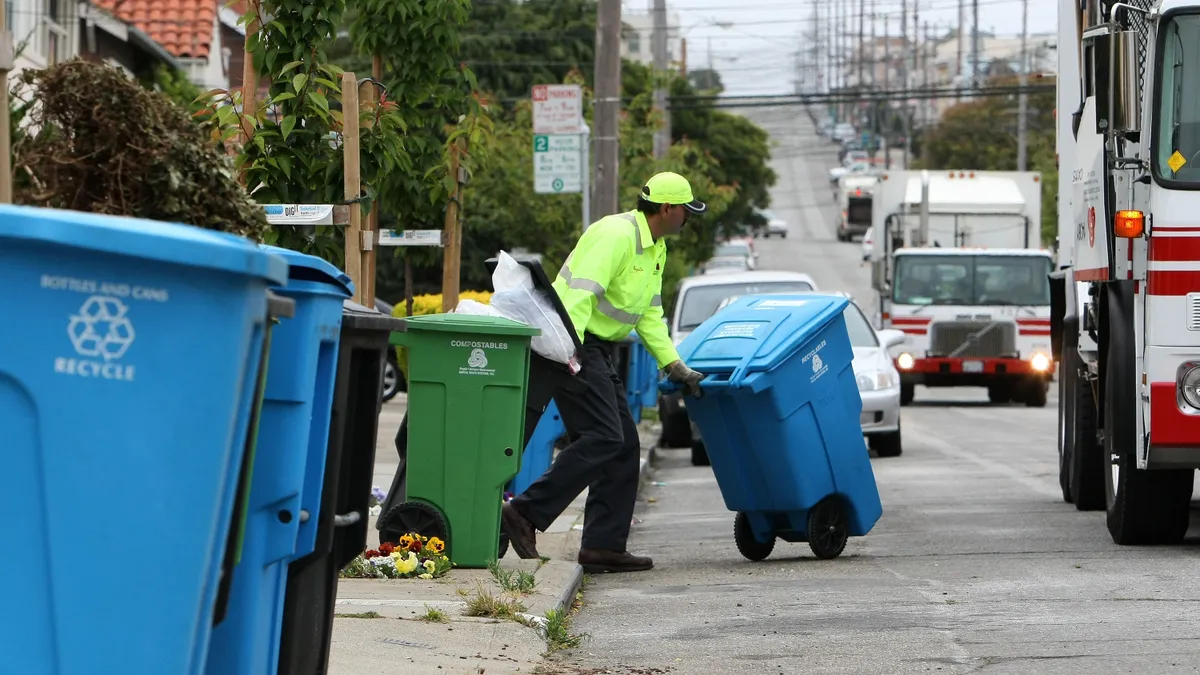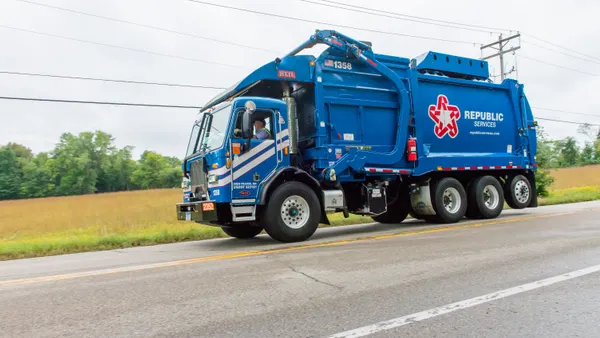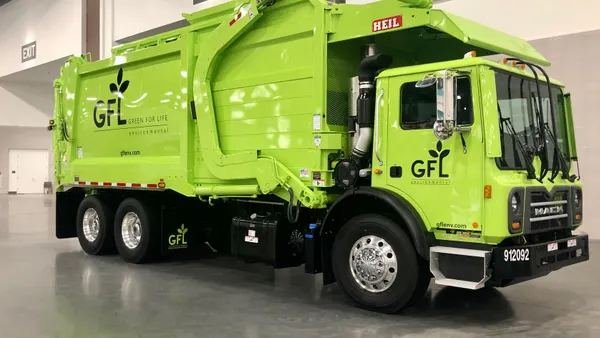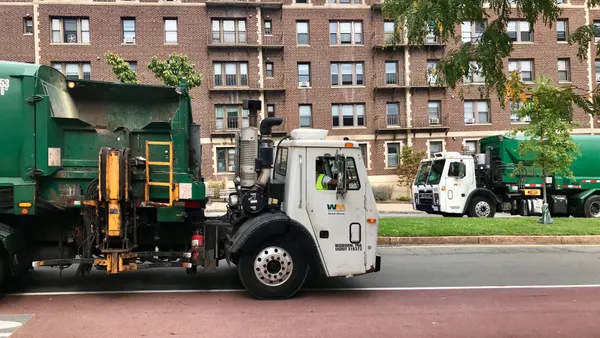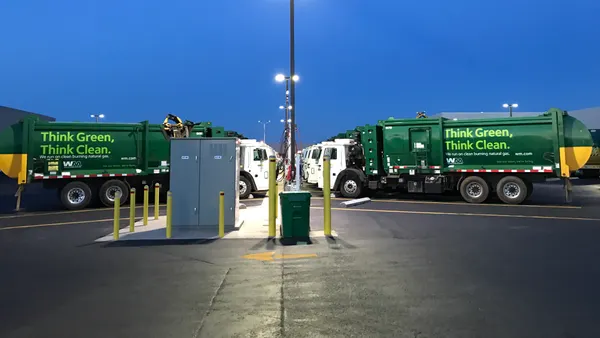The waste industry is shifting gears as it heads into 2025. A new presidential administration is likely to make significant federal policy changes. At the same time, many experts predict stable but elevated interest rates and a macroeconomic environment that remains broadly beneficial for the industry.
The Trump administration may alter or delay federal rules targeting landfill emissions and PFAS, but many states are expected to continue acting on those and other issues, including growing adoption of extended producer responsibility laws.
Elsewhere, we continue to track the growing renewable natural gas market, state and local climate regulations, labor market changes and the mergers and acquisitions that have defined the industry for several years.
We welcome your thoughts on these trends or any others. Please email us at waste.dive.editors@industrydive.com.
The Trump effect
The first Trump administration was good for the waste and recycling industry (before the pandemic hit), and sources anticipate another favorable run ahead.
While the president-elect’s proposed tariffs are causing some broader uncertainty, financial analysts are generally bullish about economic activity in the years ahead, and that means reliable waste volumes.
Trump and the Republican-controlled Congress are eager to pass a new tax package to replace a 2017 law set to expire at the end of this year. Major companies took a variety of approaches in 2018 with the proceeds from that last tax cut, including bonuses for front-line workers, upgraded facilities and stock buybacks.
The National Waste & Recycling Association says it is focused on potential tax law changes such as repealing the excise tax on trucks and updating categories such as bonus depreciation, interest rate deductions and R&D credits. A potential bill could also include changes to energy policy that might be relevant for certain landfill gas and fleet investments. The industry would prefer to see more specific changes in this area versus a repeal of the Inflation Reduction Act, according to sources.
Labor is another key area to watch for federal regulatory changes. The nomination of a Teamsters-supported labor secretary is notable, but immigration may become the dominant labor policy discussion this year.
Possible changes to the Temporary Protected Status program could have an effect on this industry, as certain companies voiced concerns about back in 2019. Broadly, the industry’s top companies have long expressed an interest in comprehensive immigration reform that could bring more people into the documented workforce for hard-to-fill driver and technician roles. While sources say the industry’s employment of undocumented immigrants is less common now, some believe that any hypothetical mass deportations could still affect the workforce or put upward pressure on wages.
Antitrust regulation could also change. Large companies across multiple industries have chafed at the Biden administration’s more stringent attitude and regulatory approach. The Trump team is expected to take a different tack, which could allow more large deals to occur. Though — as WM learned when it bought Advanced Disposal Services during the first Trump term in 2020 — some level of divestitures could still be required. If so, that could open up further M&A opportunities to help other companies grown in turn.
PFAS presents challenges and opportunities
Landfill operators will continue to monitor and invest in PFAS remediation and management in 2025. That’s despite uncertainty around the future of the U.S. EPA’s hazardous substance designation for certain PFAS under the Comprehensive Environmental Response, Compensation and Liability Act.
The waste industry sees that rule, finalized last year, as having a direct impact on daily operations. Groups including NWRA and the Recycled Materials Association have challenged the hazardous substance designation in court, and the legal proceedings are expected to move forward this year. The groups say their members are “passive receivers” of PFAS-containing material, and the CERCLA designation creates significant liabilities for operators.
Some experts say the incoming Trump administration could influence the PFAS hazardous substance designation, though it’s unclear how that might unfold. Industry groups have also asked federal lawmakers for help in carving out exceptions for “passive receivers” of PFAS-containing material, but it’s unclear whether that work will be a priority for the 119th Congress.
Meanwhile, private companies will continue to offer new and expanded types of PFAS remediation services in 2025. Some are working directly with landfill operators to develop and test the latest technologies. The EPA’s updated interim guidance on destruction and disposal methods for PFAS-containing items offers new perspectives on the technologies available for incineration, landfilling and deep-well injection.
Industry analysts expect landfill operators to continue to work with environmental services companies to provide PFAS remediation for leachate this year. Driving that, in part, are final federal standards for certain PFAS in drinking water, as well as state-level PFAS laws that are sometimes more strict or specific than federal standards.
Another unknown is how states may choose to regulate PFAS in biosolids in 2025 and beyond in the absence of direct EPA guidance. The waste and recycling industry is concerned with regulations aimed at limiting PFAS contamination, particularly for digesters or composters that receive and process the material.
Landfill facilities evolve as technology advances
The RNG industry notched what's expected to be another record year of new facility starts and production announcements, fueled by tax credits and federal policies like the Renewable Fuel Standard. That evolution has occurred in tandem with growth in landfill technologies that are expected to become more commonplace in the new year.
Advanced monitoring technologies in particular are expected to spread. Last year, the EPA issued a warning to landfill operators about proper emissions monitoring after a three-year review. New technologies to mitigate emissions, including those from companies like Qnergy and LoCI Controls, have made inroads to address emissions from the most difficult parts of landfills.
Environment and Climate Change Canada, the national regulator, which has been in the process of updating landfill methane regulations for several years, released proposed language in 2024. Observers expect an update of those regulations this year. Proposed language would incorporate drone-based systems as an approved monitoring method for landfill emissions, which could set the stage for enhanced adoption of the technology in Canada.
Satellite technologies are also expanding, as Carbon Mapper began to report data from its first satellite at the end of last year. The EPA also is continuing to research satellites and other systems on landfills to inform its next air pollution rules.
States continue climate policy work
The first Trump administration curtailed actions on climate, and some of the former president’s allies have said they want to put career civil servants “in trauma,” including by slashing budgets. The EPA under Trump previously delayed rules focused on emissions, including updated regulations for landfills. The agency is scheduled to update those rules again this year, though some believe that an EPA led by Trump’s nominee, former Rep. Lee Zeldin, R-N.Y., could attempt to delay implementation again.
Last year, state and local governments received billions in funding under the Climate Pollution Reduction Grants program created by the Inflation Reduction Act, which they used to fuel several major waste and recycling-related initiatives. This year, those entities can begin building out such programs, which include landfill upgrades, organic recycling infrastructure and other measures. Other funds, distributed through infrastructure bill programs like the Solid Waste Infrastructure for Recycling Grants, have kick-started climate action at the local level as well, where action on issues like organics is expected to continue.
Policy groups expect states to take the lead on climate work in general in 2025, with the Center for American Progress calling for "new ambitious policies" at the sub-national level to tackle emissions. The progressive think tank mentioned the work done by states like California, Maryland and Oregon to address landfill methane emissions. In 2025, Colorado is making moves to join those states in regulating landfill emissions beyond what is required by the federal government, in part by using CPRG funding.
EPR implementation — and the introduction of new bills
Five states have passed EPR for packaging laws, but so far it’s been unclear exactly how those laws will affect industry operations.
2025 will be the year that starts to change, as Maine has approved major rulemaking details, and parts of Oregon’s program are expected to start rolling out this summer. California and Colorado are expected to finalize several critical details in 2025. Minnesota, the latest state to pass EPR for packaging, will begin working on the first round of implementation in 2025, which is expected to include a needs assessment.
Three other states will work on studies or needs assessments to provide data that could serve as the foundation of eventual EPR policies. Maryland’s advisory council is continuing to draft its recommendations this year. A new Massachusetts commission could submit recommendations to the legislature by the beginning of 2026, and an Illinois advisory council plans to submit final recommendations by the end of 2026.
Meanwhile, more states are expected to introduce EPR for packaging laws this year. A bill was introduced in Tennessee earlier this week. Experts are also keeping an eye on activity from states such as Washington, New Jersey and New York.
As in previous years, these bills won’t have an easy path to the finish line due to in-depth debates from stakeholders over recycling infrastructure needs, control over materials, requirements for plastic reduction and reuse and the role of emerging technologies such as chemical recycling.
And while packaging EPR legislation garners plenty of attention, some legislatures are expected to roll out EPR bills for other types of items, such as batteries, textiles, paint and more. Trade groups such as the NWRA say they’re more supportive of that approach, especially for fire-causing batteries, than EPR for packaging.


